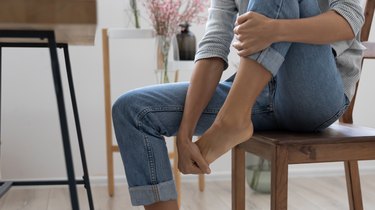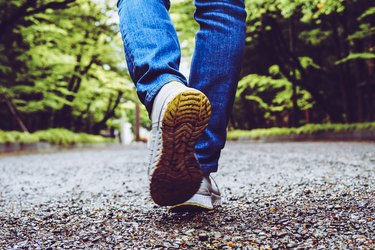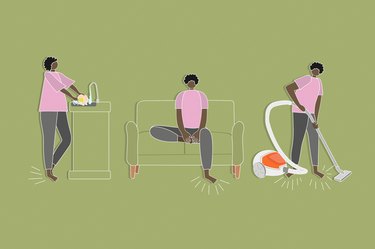
From your heel to your instep, pain can happen anywhere in your foot. But when it strikes the outside of your foot, it can be especially excruciating.
Lateral foot pain — which stretches along the outer edge of the foot and ankle — can make even the simplest movements (like standing and walking) a challenge.
Video of the Day
Video of the Day
Here, Nelya Lobkova, DPM, a New York City-based podiatrist at Step Up Footcare, explains why you might be dealing with discomfort on the outside of your foot and how to decrease the ache in your dogs.
1. Arthritis
If your lateral foot pain is usually worse in the morning and improves with motion throughout the day, you might have arthritis, a degenerative joint disease.
More specifically, arthritis in the ankle joint could be causing your side-of-the-foot aches.
"When the pain is in the lateral ankle, this typically involves post-traumatic arthritis, or joint disease [that occurs] after injury to the ankle or ankle ligaments," Dr. Lobkova says.
"Lateral foot pain could also be caused by subtalar joint arthritis," Dr. Lobkova adds. It's possible to develop arthritis in the subtalar joint (the joint just below the ankle joint) if there's an associated flat foot deformity, she says.
That's because a "severe flat foot demonstrates an abnormal angling of the heel bone, which can lead to lateral impingement of the subtalar joint," Dr. Lobkova explains.
Fix it: "Ankle and subtalar arthritis could be treated with anti-inflammatory medications (NSAIDs), immobilization with strapping and occasionally localized steroid injections," Dr. Lobkova says.
Orthotics can also offer relief. "Custom orthotics help maintain optimal positioning of the heel bone and thus impact subtalar and ankle alignment," Dr. Lobkova says. "The amount of arch support and correction in the orthotics is determined by a podiatrist using X-ray imaging and gait analysis."
What about store-bought shoe inserts? Over-the-counter orthotics are made of a soft, flexible material, so they provide limited support, Dr. Lobkova says.
Related Reading
2. Stress Fractures
A stress fracture — or a tiny crack — in the fifth metatarsal bone (the long bone just below your little toe) can produce pain in the lateral foot.
"Unlike arthritic pain, foot pain due to a stress fracture is typically a slow-onset pain that gets worse throughout the day," Dr. Lobkova says.
"This is common in people who are on their feet for long periods of time or performing high-impact exercises involving jumping or running," Dr. Lobkova says. "It is also more prevalent in high-arch feet."
Fix it: To treat stress fractures, "it's important to modify activity during bone healing, which is six to eight weeks," Dr. Lobkova says.
She advises keeping the foot immobilized in a CAM (controlled ankle movement) walker or walking boot for approximately three weeks.
In addition, "custom orthotics with a specific modification called a 'distal metatarsal pad' could be helpful in preventing the stress fracture from happening again," Dr. Lobkova says. "The metatarsal pad offloads the metatarsal bone in order to dissipate the pressure off the metatarsal head and metatarsal neck."
3. Peroneal Tendonitis
Your lateral foot pain could be linked to peroneal tendonitis, i.e. inflammation in the peroneal tendon.
This tendon runs from the outside of your leg down to a bone in the bottom of your foot, Dr. Lobkova says, and pain can occur anywhere along the tendon. However, the pain most commonly occurs behind the outside ankle bone and the outside of the foot.
Peroneal tendonitis tends to develop in runners, "especially those who do not update their sneakers often enough or increase their mileage or pace too quickly," Dr. Lobkova says.
Fix it: "I advise a period of resting, icing, compressing and elevating (RICE) for one week," Dr. Lobkova says.
Here's Dr. Lobkova's protocol for RICE:
- Rest: Stop all high-impact activities.
- Ice: Apply ice in the form of frozen corn or frozen peas around the ankle for 10 minutes, three times an hour (twice a day).
- Compress: Use an ACE bandage wrap ($13.69, Amazon) or Coban wrap ($5.99, Amazon) to contain the swelling of the ankle. Remove the wrap before sleeping.
- Elevate: Elevate the affected ankle above the level of the heart. Lie down with a few pillows under the ankle (toes above the nose) for optimal elevation.
After your week of R.I.C.E., you may also want to wear a brace or use kinesiology tape ($11.95, Amazon) for continued support.
Then, "once inflammation is reduced (typically two weeks), it is important to stretch and strengthen the tendon again," Dr. Lobkova says. "Strengthening the tendon could be done at home with exercises involving a theraband (for resistance) or in physical therapy if pain continues," she adds.
4. Bursitis
Bursitis might be the source of your side foot pain.
Bursitis happens when a bursa — a sac of fluid located around bony prominences (i.e. areas where bones are close to the surface of the skin) — becomes inflamed, Dr. Lobkova says.
Bursitis can occur on the side of the foot, around the base of the little toe, Dr. Lobkova says. "Some people can form [an inflamed] bursa in this area from uncomfortable shoes that rub on the foot and irritate the bony prominence," she explains.
Fix it: "Bursitis is treated by removing the irritant that causes the bursa to form," Dr. Lobkova says. For example, the solution may be as simple as switching up your shoes.
"Occasionally, the bursa could be made smaller and non-painful with a localized steroid injection and padding around the bursa," Dr. Lobkova says. "NSAIDs could help with the pain and inflammation as well."
Related Reading
5. Pinched Nerves
If your side foot pain is accompanied by tingling or numbness, you might be dealing with a pinched nerve.
Compression of the sural nerve — which runs on the outside of the leg down to the toes — can cause lateral foot pain, tingling or even temporary numbness to the lateral leg and foot, called neuropraxia, Dr. Lobkova says. "Sural nerve compression could be caused from a direct injury or cast use if the cast is tight around the calf area," she says.
What's more, "pinched nerves in the back from herniated disks (specifically involving L5) can also cause lateral foot pain," Dr. Lobkova says.
In this case, "the pain typically starts in the lower back and radiates down the lower leg," she says.
Fix it: "Sural nerve compression should resolve on its own with time," Dr. Lobkova says. "Laser therapy, a form of high-power light therapy, may help the nerve compression resolve faster."
If your lateral foot pain originates from pinched nerves in the back, they must be treated locally "since that is the area where the nerve signal is compromised," Dr. Lobkova explains.
6. Ankle Sprain
Sometimes it's just a simple ankle sprain that's initiating achiness on the side of your foot.
"Most often, the injury causes lateral foot pain because the ankle twists inward and sprains the lateral ligaments," Dr. Lobkova says.
In many cases, ankle sprains involve the anterior talofibular ligament (ATFL), the shortest (and most commonly injured) lateral ligament, she says.
"Recurrent sprains in the lateral ankle can cause chronic ankle instability," which can affect balance, Dr. Lobkova says.
Fix it: If you have an ankle sprain, follow the RICE protocol (Rest, Ice, Compress, Elevate) within the first 48 hours of the injury, Dr. Lobkova says. This should significantly reduce symptoms of discomfort.
"If pain continues, there may be a tear or more significant injury," Dr. Lobkova says. See a podiatrist, who can properly diagnose and advise you on further treatment, which may involve physical therapy, bracing and/or taping, she says.
7. Cuboid Syndrome
A problem with your cuboid — a small bone on the outside of the foot — could be triggering pain in your tootsies.
Cuboid syndrome is the partial dislocation of the cuboid bone in your foot, which is caused by an injury to the surrounding ligaments, Dr. Lobkova says. "When there is a tear in these ligaments, the cuboid can move upwards, causing pain in the outside of the foot," she explains.
"This is a complex condition to diagnose, and it is often misdiagnosed as an ankle sprain or peroneal tendonitis," Dr. Lobkova adds.
Fix it: "Depending on the severity of the injury, treatment involves RICE in the first 48 hours, followed by a period of immobilization in a walking boot," Dr. Lobkova says.
In more severe cases, "it may be necessary to set the cuboid back into place under local anesthesia (which could be done in your doctor's office)," Dr. Lobkova says.
8. Tailor’s Bunion
While most bunions are situated next to the big toe, a tailor's bunion, also known as a bunionette, can develop on the outside of the foot and generate pain.
This happens when a person has a genetic deformity in their foot, Dr. Lobkova says, which causes a bunion to form on the side of the foot near your little toe.
"Pain from a tailor's bunion ranges from chronic aching to sharp pain [near the little toe]," and there's typically swelling and redness in the area as well, Dr. Lobkova says.
Fix it: "Conservative treatment involves modifying shoe wear (specifically, changing to wider shoes), anti-inflammatory topical and oral medication, physical therapy and localized steroid injection," Dr. Lobkova says.
When conservative treatment fails, surgical correction of the bunionette — which involves cutting the bone and moving it into the proper position — should be considered, she adds.
Is this an emergency? If you are experiencing serious medical symptoms, please see the National Library of Medicine’s list of signs you need emergency medical attention or call 911.


